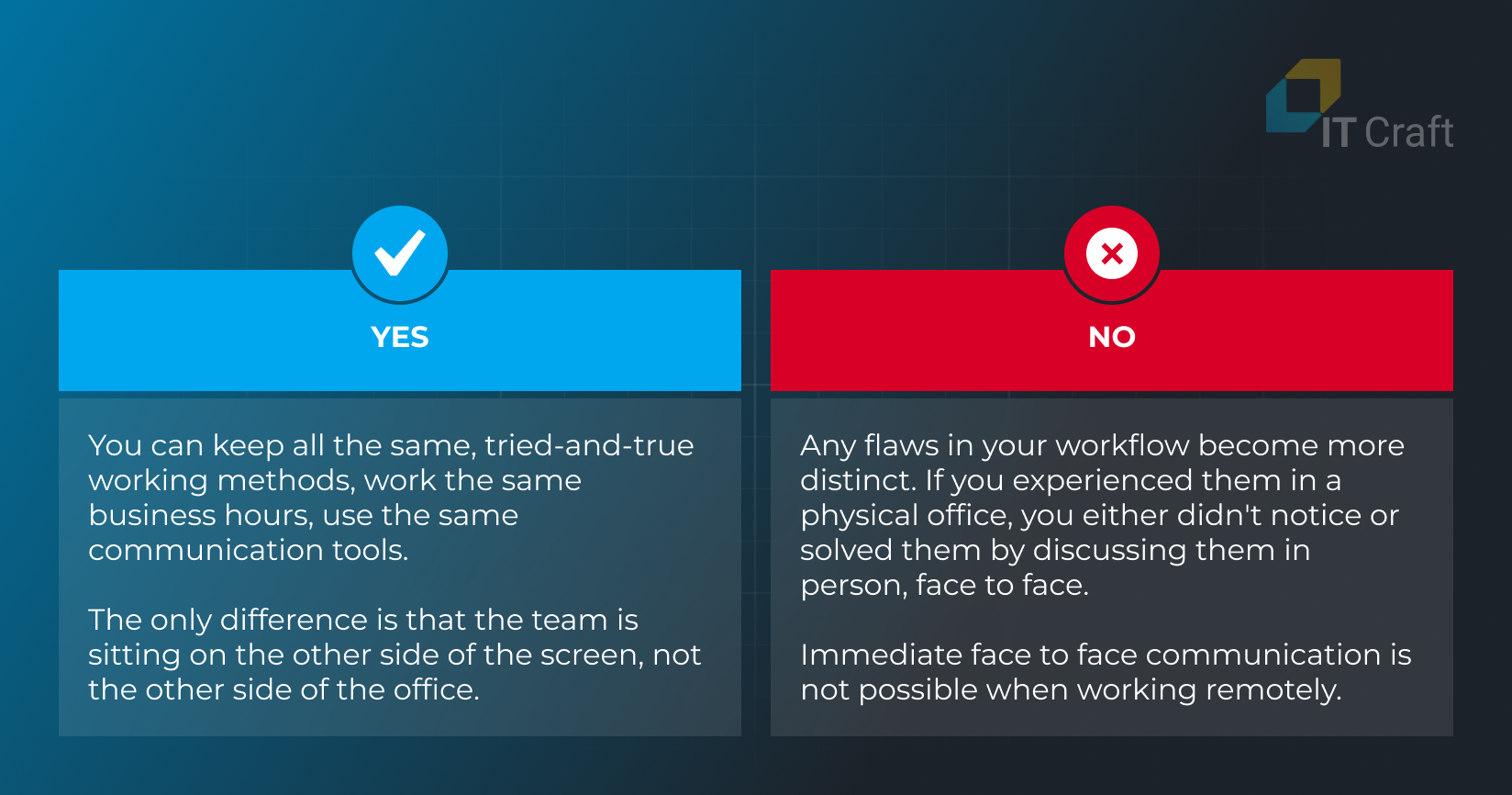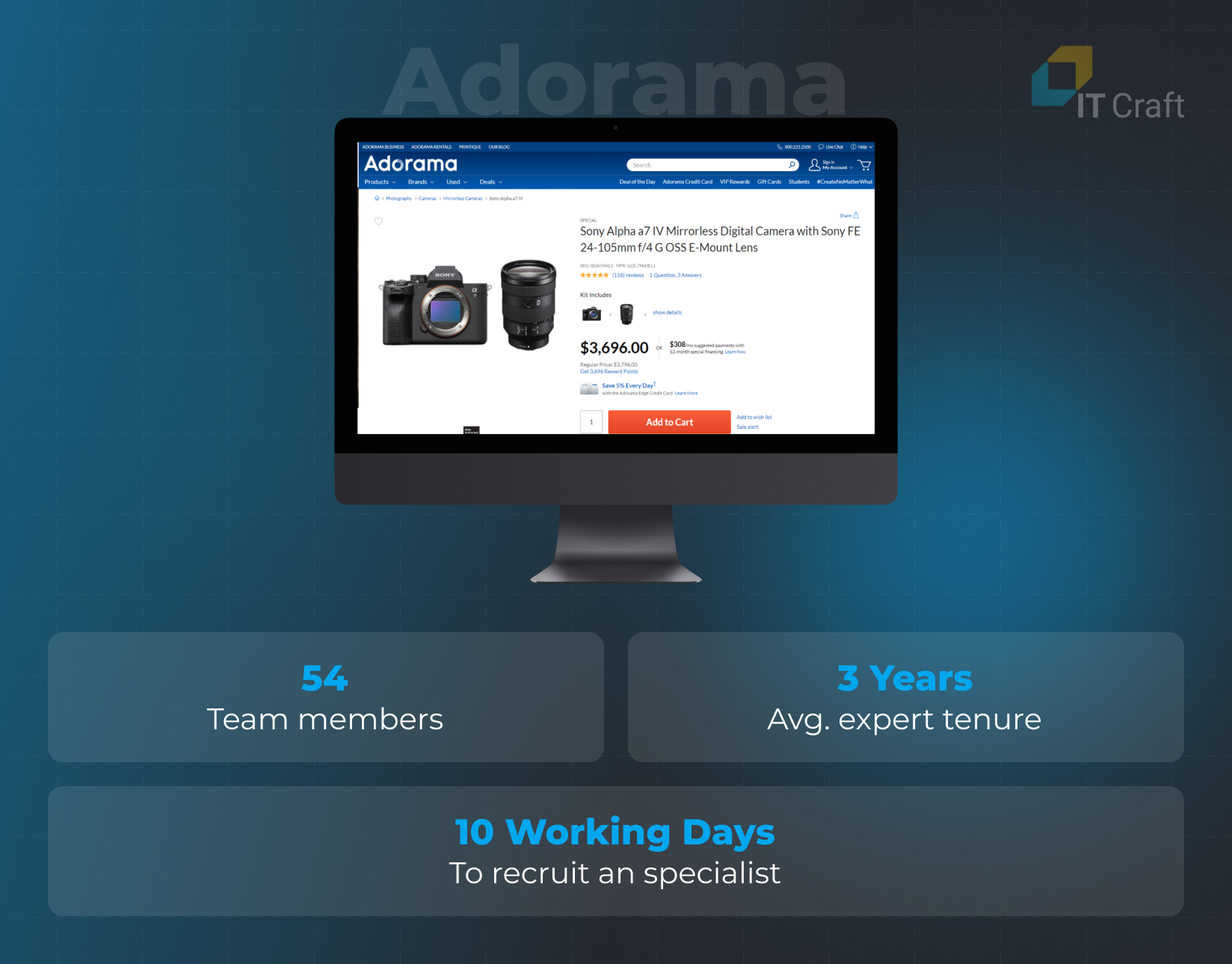As companies go global, around 44% have observed a surge in full-time employees operating remotely from various nations. This shift is especially pronounced in the IT sector, where services are frequently outsourced because of the limited availability of elite talent in Western regions.
One benefit of a custom software development project is that it can be completed remotely. Another is that project challenges are different. So are team structures.
Depending on your requirements, you can choose among the following (or build your own):
- a remote development team
- a dedicated team
- a distributed team
- an extended team
- a virtual team
Aren’t they all the same?
Not really. Although terms cross over, they have only one thing in common: they would only work on-site in your office.
1
What is a remote software development team?
A remote software development team consists of software professionals working from different locations rather than being co-located in a single office. This team could be spread across various cities, countries, or continents.
With the rise of digital communication tools and platforms, it’s become easier for developers, testers, project managers, and other key roles to collaborate seamlessly, irrespective of their physical locations.
An increasing number of firms – 60% as of 2022 – are now delegating a portion of their app development externally. As IT enterprises accelerate their operations, the trend of software outsourcing is expected to continue its upward trajectory for a decade, culminating in 2025.
2
Types of Remote Development Models
In the age of globalization and technological advancements, businesses are tapping into various remote development models to drive efficiency, access a wider talent pool, and ensure agility.
These models, each with unique attributes and applications, can significantly impact how teams function and deliver.

In this model, every team member works independently from their preferred location, whether at home, a café, or a co-working space. There is no central physical office.
This model emphasizes trust and autonomy, offering team members maximum flexibility. However, investing in top-tier communication and project management tools is paramount to maintain cohesion and ensure timely deliveries.
A blend of traditional and modern work practices, mixed teams have onsite and remote team members. This facilitates the advantages of in-person meetings, brainstorming sessions, and the flexibility of remote work. This model can cater to individual preferences, often increasing team morale.
- Offshore Development Centers (ODC)
Businesses establish dedicated teams in foreign countries to leverage cost benefits and access skilled talent unavailable in their home country.
While ODCs can yield significant cost savings, cultural training and regular alignment meetings are essential to bridge understanding gaps.
By setting up teams in neighboring or nearby countries, companies can minimize the challenges posed by vast time zone differences. This ensures more overlapping working hours and leads to smoother communication and quicker turnaround times.
Although team members predominantly work remotely, they periodically convene at shared co-working spaces or hubs for collaborative sessions. This approach attempts to fuse the autonomy of remote work with the collective energy of physical gatherings.
As the world of work continues to evolve, understanding and choosing the right remote development model becomes crucial. It not only determines the logistical aspects of project execution but also plays a pivotal role in team dynamics, collaboration efficiency, and overall project success.
3
Choosing development model
Outsourcing software development helps save overhead costs and supplements expertise in a project. However, choosing the wrong cooperation strategy could have dire circumstances.
What kind of team does your project need?
Should you hire a remote software development team or a single freelancer?
It depends on:
- budget
- size
- deadline
- project perspectives (short-term, long-term)
- managerial strategy
Let’s look at more details.
The Difference Between Remote and Dedicated Teams
Regarding software development, a “remote team” is a group operating outside the main office. This team could function from various offices in different nations. The primary distinction between a remote and an in-house team lies in their operational locations.
The “dedicated team” model describes a scenario where a service provider offers a client a specialized remote team for extended collaboration. The remote partner handpicks candidates aligning with the client’s stipulated skills and experience criteria.
Broadly, “remote” encompasses employees operating away from the central office. Meanwhile, the “dedicated” framework points to a tailor-made remote squad primed to engage with you for an extended duration.
Integrating remote and dedicated team models can profoundly transform and elevate your digital branding approach.
Empower Your Project with a Dedicated Team!
Access a world of expertise with our remote developers.
Reach out to us today!
Why Choose a Remote Software Development Team
Opting for a remote development team presents multiple advantages for businesses in this increasingly digital and globalized age. Here are some compelling reasons to consider:
Often, hiring remote teams from regions with a lower cost of living can lead to significant savings without compromising on quality.
- Access to a Global Talent Pool
By not being limited to a specific location, businesses can tap into a vast reservoir of skills and expertise from across the globe, ensuring top-tier quality for their projects.
Remote teams can work around different time zones, allowing for continuous development cycles and faster project completion.
This streamlined initiation guarantees that your crucial deadlines are met efficiently and precisely, setting the stage for a successful and timely project delivery.
It’s easier to scale up or down with remote teams based on project requirements. This adaptability can be crucial for startups and growing businesses.
Bringing together professionals from varied backgrounds can infuse projects with innovative ideas, fostering creativity and out-of-the-box solutions.
- Reduced Operational Overheads
Without physical infrastructure, utilities, and other associated costs of maintaining an in-house team, overheads can be substantially reduced.
Remote teams can ensure that operations continue despite unforeseen challenges, such as natural disasters or pandemics, which might disrupt a centrally located team.
- Enhanced Employee Satisfaction
Offering the possibility of remote work can lead to higher job satisfaction, reduced turnover, and improved work-life balance for remote software development team members.
For niche projects, finding and onboarding specialists from the global market is easier than being constrained by local talent availability.
Reduced commuting means a lesser carbon footprint, making remote teams a more sustainable choice in the long run.
In essence, embracing a remote development team is not just a trend but a strategic decision that can drive growth, efficiency, and innovation for businesses in today’s interconnected world.
When a Dedicated Team Works Better, and When It Doesn't
The post-pandemic world has shifted paradigm, with remote work transitioning from a luxury to a near necessity. A striking statistic underlining this trend is that 64% of employees would choose to resign rather than return to the office full-time.
Going remote might be unnecessary if surrounded by a cluster of proficient developers equipped to undertake your project. Conversely, a remote setup might be inevitable if such talent is geographically distant or you’re scouting for niche expertise.
While the above outlines a broader perspective, let’s pinpoint specific scenarios advocating for a dedicated team:
Situations Favoring a Dedicated Team:
For lengthier endeavors, a dedicated team is apt. They can be swiftly mobilized, and this model vouches for their commitment and quality of work.
Leveraging a dedicated team can lead to substantial cost savings, offering quality output without breaking the bank.
If you’re contemplating a shift in your company’s direction, the dedicated model is optimal to onboard the requisite personnel quickly.
A dedicated team’s streamlined processes and familiarity with the project can significantly accelerate development speed, ensuring your product reaches the market faster.
However, certain circumstances might not align with a dedicated team:
Engaging a full-fledged dedicated team for brief projects could be more pragmatic. Here, individual developers or freelancers might be more apt.
For tasks not at the forefront of your agenda, dedicated teams, which require consistent oversight, might be overkill and divert attention from principal ventures.
Remember, the right choice hinges on your venture’s unique demands and nuances.
4
Tips on building an effective remote workflow
Do you need help managing people working in different places than you? Yes and no. It’s different.

An effective remote workflow is pivotal for optimizing productivity, fostering team cohesion, and ensuring successful project delivery.
Here are some insightful tips to guide you:
01 Set Clear Expectations
Clearly outline responsibilities, deliverables, and deadlines. When everyone knows their role and what’s expected, it reduces ambiguities and boosts productivity.
02 Regular Check-ins
Daily or weekly team check-ins can provide structure, allow for updates, and facilitate real-time problem-solving.
03 Document Everything
Maintain comprehensive documentation for tasks, decisions, and processes. This ensures everyone stays on the same page and can quickly refer to necessary information.
04 Cultivate Trus
It’s vital to trust your team. Avoid micromanaging and give them the autonomy to manage their work while ensuring they’re accountable for their deliverables.
05 Flexible Scheduling
Recognize that everyone might not be in the same time zone. Allow flexibility in work hours, focusing more on output quality and adherence to deadlines.
06 Prioritize Communication
Foster open channels for communication. Encourage team members to share concerns, provide feedback, and brainstorm, building a cohesive remote environment.
07 Onboarding and Training
Ensure new members are introduced to tools, processes, and company culture. Regular training sessions can also help update existing team members about new tools or methodologies.
08 Cultural Sensitivity
When working with a global team, it’s important to understand and respect cultural differences. This can foster a more inclusive and harmonious work environment.
09 Feedback Loops
Implement regular feedback sessions. This helps identify improvement areas and celebrate successes, ensuring continuous growth and refinement of the workflow.
10 Cybersecurity Measures
With varied access points, ensure that your remote software development team follows best practices for security. Regular updates, VPNs, and two-factor authentication can safeguard your data.
By carefully integrating these tips, businesses can unlock the full potential of remote work, ensuring that distance becomes just a number and not a barrier to success.
Ready to Elevate Your Software Game?
Our expert remote teams await your vision.
Reach out today!
5
Navigating Leadership: How to Manage a Remote Software Dedicated Team
Managing a remote software development team has become a quintessential skill for many leaders as the global workforce evolves. Though the terrain is fraught with unique challenges, having a clear roadmap ensures smoother journeys.
Effective leadership in this realm doesn’t merely echo traditional managerial practices; it often demands novel approaches, especially given the pivotal role of communication.
Recruit with Precision and Nurture Trust
Hiring decisions should be made with acute discernment:
- Conduct thorough interviews, delve into work portfolios, and assign trial tasks to assess competencies.
- Post-hiring, build a culture of trust. Remember, a trusted developer is often a more motivated and efficient one.
Institutionalize Seamless Communication Channels
Lay the groundwork for clear and continuous communication:
- Opt for reliable tools and platforms tailored for remote collaboration. Tools like Slack, Trello, Zoom, and Microsoft Teams often lead the roster.
- Recognize the challenges posed by time zone disparities. Establish common meeting times that respect everyone’s working hours.
- Schedule daily touchpoints for task updates and a more exhaustive weekly review to understand progress and address challenges.
Reinvigorate Virtual Interactions
Combat the potential dreariness of virtual meetings:
- Kick-off sessions with personal check-ins or light-hearted discussions.
- Rotate meeting leadership to foster inclusivity and engagement.
- Recognize and celebrate milestones, both big and small.
- Use a mix of infographics, slides, and interactive elements to keep participants engaged.
- Ensure all voices are heard. Consider tools or methods that allow anonymous feedback or questions.
Drive Team Morale and Productivity
Steer the team towards consistent motivation and focus:
- Implement time-management tools that also provide insights into productivity patterns.
- Ensure regular, constructive feedback loops. Recognize excellence and guide areas of improvement.
- Emphasize the collective impact of the team’s work, drawing clear connections between daily tasks and the broader company mission.
Utilize Established Development Frameworks
Embrace methodologies that amplify output and cohesion:
- While Agile remains a favorite, consider other methods like Kanban or Lean, depending on the team’s dynamics and project requirements.
- Continuous training sessions can keep the team updated on these methodologies' latest trends and best practices.
Architect an Integrated Information Infrastructure
Incorporate platforms that facilitate seamless information flow:
- Platforms like GitLab, GitHub, or Bitbucket offer an ecosystem for code management, while tools like Confluence can serve as knowledge repositories.
- Ensure that these systems offer transparency, enabling all team members to access the information they need when they need it.
Cultivate a Unified Development Ethos
Strive for harmony in development practices:
- Facilitate workshops or brainstorming sessions to derive collective best practices and protocols.
- Whether coding standards, documentation practices, or design philosophies, ensure the team has clear guidelines and understands their importance.
Pioneer Remote Team-Bonding Exercises
The virtual space offers a plethora of bonding opportunities:
- Organize monthly virtual team dinners, where members share their meals over video calls.
- Consider virtual escape rooms, online gaming sessions, or shared movie nights to build camaraderie.
- Occasionally, plan for in-person retreats or workshops. These can be invaluable in fostering deeper connections.
Optimize Team Expansion with Advanced Tools
As your team grows, utilize tech-driven solutions to estimate and streamline the expansion process.
Sailing the seas of remote team management can be demanding, but with the right strategies and a dash of innovation, leaders can ensure their ship doesn’t merely float but cruises with flair.
-

Navigating the complexities of remote teams is just one piece of the puzzle. If you're exploring expanding your current workforce, our "Team Augmentation: Complete Implementation Guide" provides a comprehensive roadmap to ensure seamless integration and collaboration.
6
Challenges to Managing Remote Dedicated Teams
The shift towards remote dedicated teams has provided businesses unmatched flexibility, access to global talent, and significant cost savings.
However, leading these teams does come with its set of challenges. Understanding these challenges is crucial for effectively overcoming them.
01 Communication Barriers
- Scenario: Diverse time zones can lead to disjointed communication when team members are spread across the globe.
- Impact: Miscommunication or lack of clarity can stall projects and affect outcomes.
- Solution: Implement a robust communication platform that accommodates different time zones. Schedule regular meetings at mutually convenient times and use asynchronous communication tools effectively.
02 Lack of Team Cohesion
- Scenario: Physical separation can sometimes result in a feeling of detachment among team members.
- Impact: A team lacking strong connections might not possess the collaborative spirit needed for innovative solutions.
- Solution: Organize virtual team-building activities and encourage informal interactions to foster camaraderie and strengthen team bonds.
03 Security Concerns
- Scenario: Working remotely can introduce security vulnerabilities, especially if accessing project data from unsecured networks.
- Impact: Possible data breaches might jeopardize project confidentiality and client trust.
- Solution: Enforce strict cybersecurity protocols, use VPNs, and conduct regular security training to educate team members about best practices.
04 Monitoring and Accountability Issues
- Scenario: The absence of a conventional workspace can make it challenging to track progress and ensure accountability.
- Impact: This could result in decreased productivity or compromise the quality of work.
- Solution: Utilize project management tools for tracking progress and ensuring accountability. Regularly set clear expectations and conduct performance reviews.
05 Technical Glitches and Infrastructure Issues
- Scenario: Remote team members might encounter unstable internet connections, software crashes, or hardware failures.
- Impact: Technical disruptions can interrupt work continuity, leading to project setbacks.
- Solution: Provide team members with necessary technical support and ensure they have reliable equipment. Have contingency plans in place for quick resolution of technical issues.
06 Training and Skill Development Limitations
- Scenario: Virtual setups may not provide the same hands-on training experiences as traditional settings.
- Impact: Team members might need more essential training, resulting in knowledge disparities.
- Solution: Create comprehensive online training modules and encourage ongoing professional development through virtual workshops and e-learning platforms.
07 Onboarding and Integration Hurdles
- Scenario: Welcoming new members into remote teams and acclimating them to the team's culture and tools can be more intricate in a virtual environment.
- Impact: Newcomers might experience longer adjustment periods or feelings of initial isolation.
- Solution: Develop a structured virtual onboarding program that includes orientations, introductions to team members, and training on tools and processes. Assign mentors to help newcomers acclimate.
By being aware of these challenges, teams can adopt proactive strategies, utilize modern tools, and cultivate a flexible approach to ensure effective management and collaboration.
7
IT Craft experience in remote development team services
IT Craft pioneers in remote development, leading global remote teams and diverse projects. We’ve mastered remote challenges through agile methods and clear communication, valued by clients for cost-effectiveness and continuous operation.
Our expertise and continuous innovation make IT Craft a prime choice for businesses seeking efficient remote team management and development.
Adorama's E-Commerce Evolution with IT Craft
Between 2007 and 2019, IT Craft significantly uplifted Adorama’s e-commerce platform and developed a new revenue stream through expert staff augmentation. Our involvement extended beyond mere technical support; it was a comprehensive partnership aimed at enhancing customer satisfaction and accelerating feature deployment on the platform.
Impact and Results:
- Growth: Our team expanded tenfold, reflecting our increased involvement and Adorama's trust in us.
- Efficiency: We streamlined recruitment, filling specialist roles in 10 days on average.
- Reliability: We achieved 99.8+ uptime, showcasing our commitment to a dependable user experience.
- Cost Efficiency: Maintained adherence to budget estimates, resulting in 43% savings on the IT budget.
- Revenue Growth: Contributed to generating over $500 million in annual recurring revenue, underscoring the project's financial success.
Journey Highlights:
- Initial Engagement: We began with a small task, quickly showcasing our capabilities.
- Expansion: We scaled our team and responsibilities, taking on more of the main project.
- Reliability: We achieved 99.8+ uptime, showcasing our commitment to a dependable user experience.
- Diversification: 54 team members at peak, working on multiple platforms for enhanced growth.
- Transition: After meeting our goals, we smoothly returned the project to Adorama's in-house team.

Amesto Translations: Cloud Portal Development with IT Craft
From 2017 to 2020, IT Craft provided staff augmentation services for Amesto Translations, a leading translation company in Scandinavia and the UK. We tackled challenges like tech vendor underperformance, workflow adjustment, and software modernization to deliver a seamless, modern cloud portal.
Impact and Results:
- Rapid Transition: Project takeover in 10 days, full system relaunch in 7 months.
- Cost Efficiency: Up to 24% reduction in the development budget.
- Strategic Positioning: Unique market position with seamless tech updates and timely feature deliveries.
Business Benefits:
- Flexibility: Dynamic team composition according to project scope.
- Communication: Direct, proactive interaction with the client.
- Transparency: Open access to all team members, facilitating workflow.
- Management: Dedicated PM to streamline coordination.
Roadmap & Continuity:
Despite acquiring Amesto’s translation division, the high-quality service led to continued collaboration and team transfer to a new product.

!
Conclusion
Embracing remote dedicated teams has unlocked a world of potential for businesses, bringing global talent to our virtual doorsteps. While the journey is laden with unique challenges, from time zone differences to tech hiccups, the rewards are undeniable.
Navigating this terrain requires more than good management—it calls for adaptability, innovative thinking, and a strong emphasis on communication. As we lean further into this digital age, mastering the art of managing remote teams is beneficial and essential for forward-thinking success.
Dive in, stay connected, and let’s reshape the future of work together!








